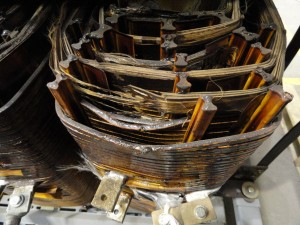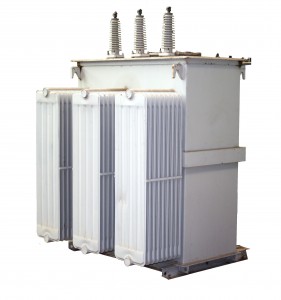Power Transformer – Visible Defect at Top of Winding
MIDWEST frequently rejects equipment even thought it passes the electrical tests. Here’s an obvious example. MIDWEST’s Switchgear Shop rejected a 225 kva 480 volt delta to 480/277 volt wye dry type electrical transformer. We only had the core and coils, not the enclosure. The insulation resistance, winding resistance, and turns ration test results were all good. The transformer was energized at full primary voltage and had proper secondary voltage for the tap position. This all sounds good. So, why was the transformer classified scrap junk? An inspection revealed the top two turns of the primary windings of one barrel had been crushed down. Something had been dropped onto these winding turns and pushed them down and separated them. The damage wasn’t physically dramatic. It was almost inconspicuous. But it was fatal to the transformer. In addition, this damage didn’t appear to have caused the fault that blew the fuses that resulted in the owner sending us the transformer to check it out. But we also found one of the ‘unused’ tap tabs was melted off to the point the bolt hole was completely gone. The end of the tab looked very clean. The transformer was connected in a different tap. On top of all this, the side of the winding seemed blackened by an apparent arc blast. Apparently the bolted connection at this tap became loose and the arcing completely destroyed the tap connection. The taps of the transformer were changed in an effort to restore power until a replacement transformer was installed. Sometimes the physical damage to electrical power transformers is very obvious. In this case, the damage to the electrical transformer was not as obvious as one might think. At least until after it was found. Test results alone can not be used to evaluate the condition of electrical dry type power transformers. The transformer must also be thoroughly inspected. What MIDWEST calls a ‘hard focus’ inspection.

